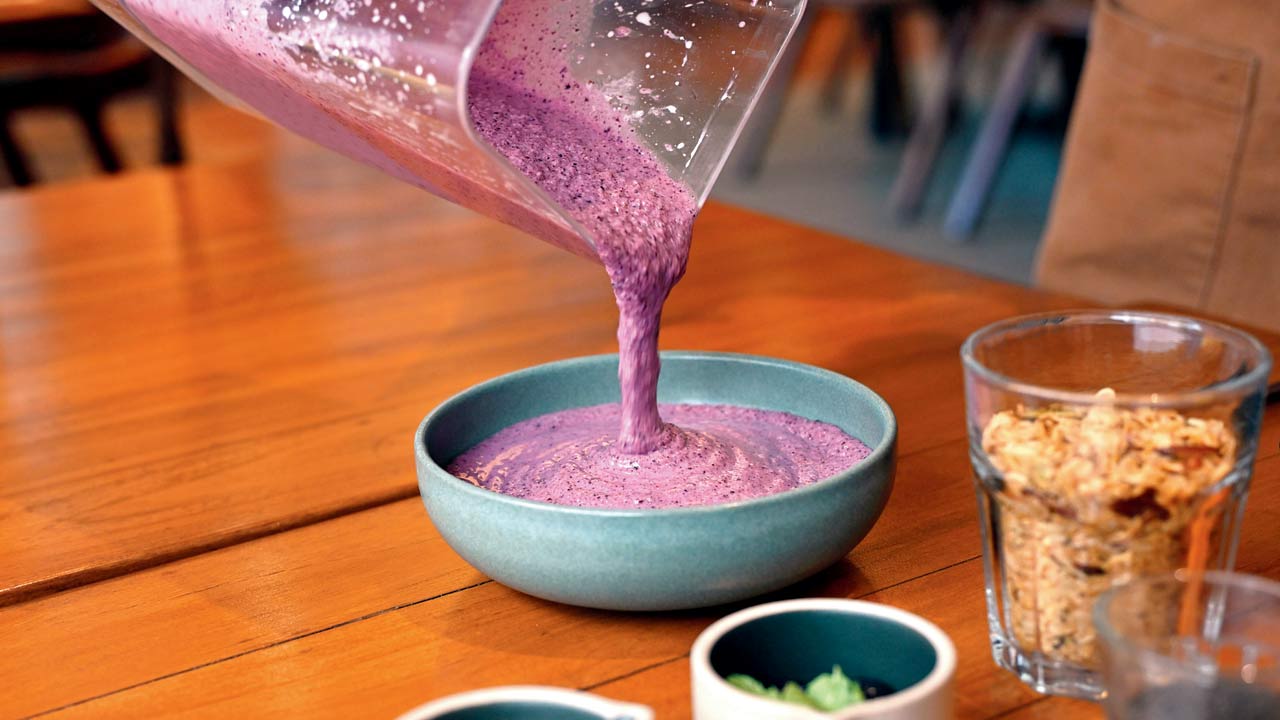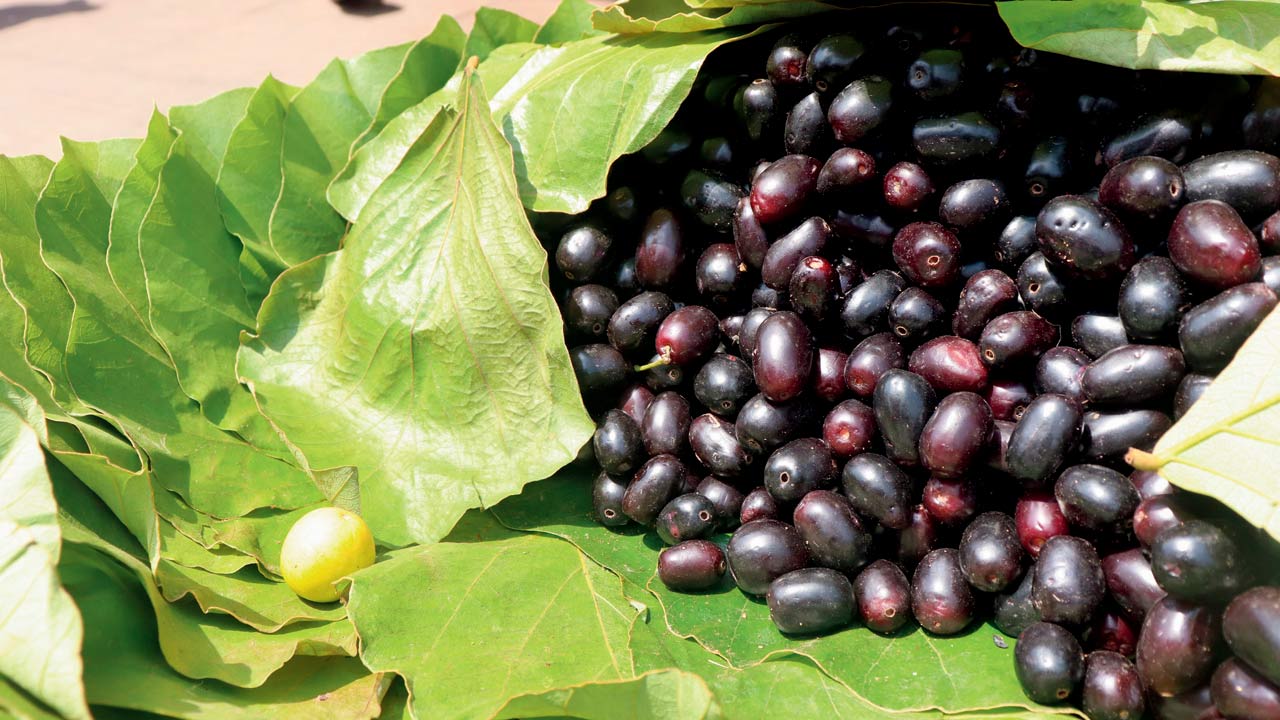Replace freeze-dried imported acai and go vocal for local with fresh, seasonal berries

Chef Karishma Sakhrani advocates locally grown berries as substitutes for acai berries. She has curated the recipe for nourishing bowls at Communion Cafe, Belapur. Pic/Kirti Surve Parade
The world is our oyster, and in today’s times, it also encloses ingredients from all shores. One such recent traveller, the Brazilian acai berry, is making its presence felt in the city’s smoothie bowls and drinks. Deconstructed, an acai bowl typically consists of a base made from puréed berries, blended with other fruits like bananas or blueberries, and a liquid such as almond milk or coconut water, topped with granola, sliced fruits, nuts and seeds.
ADVERTISEMENT
Nutritionist Sarah Vazirali, who practises behaviour counselling and evidence-based MI methods, emphasises that while acai berries are a powerhouse of antioxidants, nutrients, and fibre sources, they come to us all the way from Brazil—freeze-dried and powdered, leaving a significant carbon footprint. This fact should make us more responsible of our food choices.

“Their colour comes from anthocyanin, which is very beneficial,” she says. “We have many free radicals in our body. The environment and food we consume are responsible for it. Due to oxidative stress, there’s a lot of inflammation, especially in the Indian population. We are leading in Type 2 diabetes. The antioxidants in acai berry are high in vitamins and minerals. However, in frozen form, you hardly get anything out of it.”
Indian berries such as amla, jamun, falsa, mulberries (mainly in winter), and ber (Indian jujube) are packed with vitamins, minerals, and nutrients similar to acai, but we fail to recognise this. “Be mindful of the time of the day you consume berries–they are best before 4 pm,” points Vazirali. “Have on an empty stomach and not as a dessert after a meal.”

Sarah Vazirali and Karishma Sakhrani
Chef Karishma Sakhrani advocates using locally grown berries as substitutes for acai berries. She has curated some nourishing bowls at Communion Cafe in Belapur using locally grown blueberries. “My secret spin is a big squeeze of lemon juice to cut the sweetness of the berries and banana,” says Sakhrani, adding, “In India, we are fortunate to have a variety of locally grown berries like strawberries, blueberries, and mulberries that can easily replace acai berries. The preparation process remains the same—blend the berries with yoghurt or milk and top with local fruits, nuts, and seeds. I have established contacts with local farmers who supply quality ingredients directly to our kitchen. This gives me greater control over the quality of the ingredients used, and it helps us support local farming communities.”
Sakhrani believes incorporating phalsa, jamun, and even ber into bowls and smoothies can be an excellent way to add variety, flavour, and nutritional benefits to our diet. These berries provide comparable, if not superior, nourishment to acai berries, with unique health benefits,” she adds, sharing some delicious recipes to try at home using Indian berries when they are in season: Pair phalsa with mint, lemon, and coconut. Ber goes well with ginger, cinnamon, and honey, and jamun pairs nicely with yoghurt, banana, and lime.

For a refreshing jamun smoothie, she blends a cup of de-seeded purple berries, a banana, half a cup of almond milk, lime and honey. She recommends serving this in a tall glass filled with ice. Indian berries, in her opinion, have a tangy sweetness that distinguishes them from acai berries. “I don’t think international trends are always bad. Some of them inspire you to experiment in the kitchen and create your interpretation or highlight how similar our cultures can sometimes be—case in point: Dalgona coffee vs pheti hui coffee,” she says.
Berry Bowls
>> Base: Mix yoghurt, coconut milk, or almond milk.
>> Berries: Add fresh or frozen phalsa, ber, and jamun.
>> Toppings: For sweetness, enhance with granola, nuts, seeds (chia or flax), coconut flakes, and honey or maple syrup.
>> Additional Fruits: Combine with bananas, mangoes, or pomegranates for extra flavour and nutrition.
Nutritional benefits
Phalsa, the Indian summer special, is a sherbet berry rich in antioxidants, Vitamin C, and minerals such as potassium and magnesium. It has anti-inflammatory and cooling properties. Ber, consumed till August, is high in vitamins (especially Vitamin C), antioxidants, and fibre. It is excellent for immunity and digestive health.
Jamun is packed with antioxidants, Vitamin C, and iron. It is known for its blood sugar-regulating properties and digestive benefits.
 Subscribe today by clicking the link and stay updated with the latest news!" Click here!
Subscribe today by clicking the link and stay updated with the latest news!" Click here!












